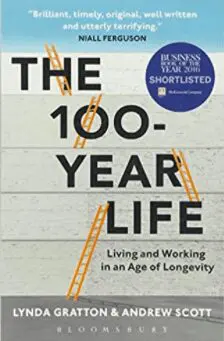The 100 Year Life: Living and Working in an Age of Longevity
By Lynda Gratton and Andrew Scott (2016 – London, Bloomsbury)
Book Review by Joe Casey
Let’s look ahead a bit – or back a bit – and imagine. It’s your 60th Birthday Party.
You receive the best gift of all time.
You’re given more 30 years of life. How would you react? Psyched about all you get to experience and do? Scared about what lies ahead? Well, according to statistics the authors cite, if you are 60 today, you have a 50 percent chance of living to 90.
In Short
It’s very difficult to see a sea change when you’re in the middle of it. The 100 Year Life provides a primer on the trends unfolding in human longevity – and a clear-eyed look at both the ramifications and the opportunities. This books offers a paradigm shift in how to think about retirement – for government policy makers, corporate executives and individuals alike.
Lynda Gratton and Andrew Scott are professors at the London School of Economics and approach longevity from two different academic perspectives – Management and Economics. The authors note that given the increases in the lifespan, many of us will indeed live longer – and we will either dread the reality of working significantly longer or embrace the gift of additional years and what we can do with them. That depends upon many factors,including our attitude and how well we plan ahead.
Food for Thought
Government policies, corporate programs and individual attitudes about retirement are based off an old model of retirement that’s obsolete. Because people are now living longer, the authors argue that the models of thinking about retirement need to change.
The old model looked at life as unfolding in three broad phases:
- Education (childhood and adolescence)
- Adulthood (focused on career and raising a family)
- Retirement (the end of working and a period of leisure)
What’s changing is that the “Retirement” period will now often be much longer. It will encompass multiple phases – instead of one. It will include several transitions, not just the abrupt transition from working to retiring in the old model. Gratton and Scott argue that we need to shift our thinking about retirement to account for this probable gift of time and the multiple stages and transitions that will be involved.
Takeaways
The new model drastically changes how we need to plan for retirement. Clearly people will need to save and invest with the possibility of a longer retirement in mind. From a non-financial standpoint, people will also need to plan for how they want to optimize the potential gift of additional years in retirement, including lifestyle, health care, work and leisure pursuits.
The authors note that this with this longer retirement, it’s wise to invest in planning and preparation, because the consequences of bad decisions can be severe. However, this new model of a longer, multi-phased retirement is uncharted territory. They point out that there are few role models and road maps to reference. You have to build your own. They advocate experimenting with new paths as a way to discover what works best for you – and to limit the downside risks.
In addition, Gratton and Scott highlight that this new model of retirement a highly individualized journey.
They ask:
“What will make it essentially your journey? The answer lies, in part, with the choices you make and the values you live by. It is these that will define and shape the sequence of events, stages and transitions that together become your accumulated sense of self – your identity.” – (The 100 Year Life – page 214).
Kickstarter
- What if ?
- What if you live to 90 – or beyond?
- What shifts will you need to make in your retirement planning?
- What’s your attitude about retirement?
- What plans could you make for work, leisure and your lifestyle if you have the gift of extra time?

